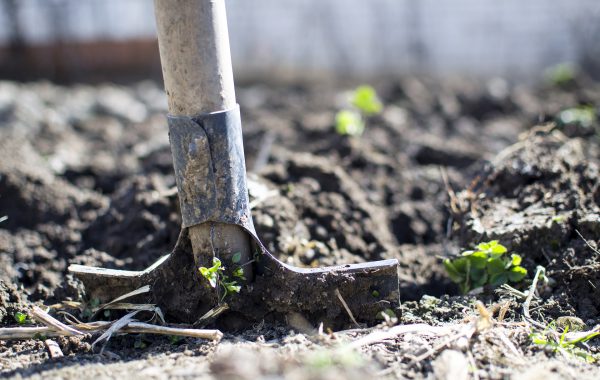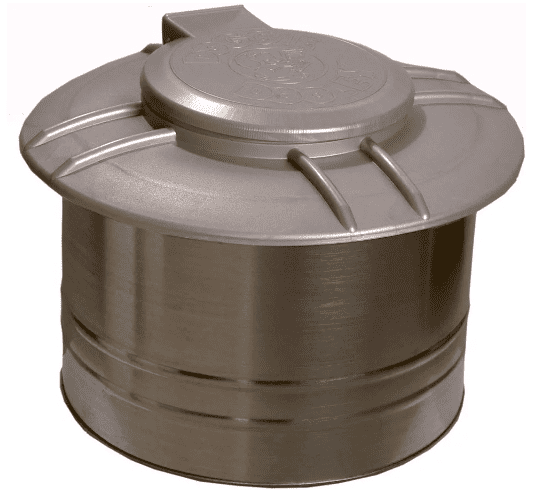With all the snuggles and cuddling your dog or cat might bring, there’s always a downside to owning a pet. Anyone who has carelessly walked around their backyard or forgotten to change their cat’s litter box is quickly reminded of the droppings your furry friend leaves behind.
Litter box or pooper scooper duty is a smelly task, but there is a better way to do it without stinking up your trash can. Forewarned, while composting dog or cat poop is possible, it’s usually easier to bury it, as we go into below, or place it in a paper yard bag for your local trash to take away.
Compost Cat and Dog Waste with Trench Composting
If there is a one size fits all solution for composting cat or dog waste, it’s trench composting. Also, if you have any other food scraps you could not typically compost, like meat or dairy, these can be thrown in too.
This method requires a bit of work, but the concept is simple, and all it requires is a shovel. Just be sure to locate where power, gas, or water lines are buried on your property before you begin digging. In the United States, you can call 811, and they will mark the lines for you, for free.
It’s recommended to keep the trench or holes you dig at least 11 feet away from any edible crops or edible crop areas. Also, pay attention to which way the water drains on your property. You don’t want water running through the poo onto an edible crop area.
Dig a rectangular trench in your yard about 2 feet deep, or deeper if you have a significant amount of waste and scraps. Move the dirt off to the side and lay an even layer of waste in the trench. If you have leaves, dead grass, or other organic material, throw that in as an even layer as well.
Replace the soil and be sure to cover the waste with at least 18” of soil. Compact the soil down to help ensure any curious critters won’t try to dig up the compost.
Trench Compost Variation
If you have smaller amounts of waste, a quicker way to get rid of a week or a few weeks’ worth of waste is to dig a smaller hole. Using a post-hole digger, you can quickly bring up a smaller amount of dirt and replace it once the contents are in it. Again, paying attention to bury it at least 18” beneath the surface.
How Long Until the Compost Is Ready?
If you’re composting cat or dog poo in the fall, this works great for springtime flowers or other non-edible plants you plan on placing there. Pet waste takes a little while to compost while beneath the surface, anywhere from 3-6 months is about average, although this will vary depending on local conditions.
Tips for Composting Cat Poo
Start by buying the right cat litter. Clay-based, sand-based, and litters containing deodorizing crystals will not break down. Choose a cat litter that is made from pine, cedar, or is paper-based. These litters are biodegradable and will decompose with everything else.
The problem with cat poop, unlike dog poop, is cat waste can carry Toxoplasma Gandii, a parasite that causes Toxoplasmosis in humans – a potentially fatal condition. Therefore, apart from handling with caution and thoroughly washing your hands and clothes, cat poop needs to be almost entirely inaccessible after the composting process starts.
These parasites are why the trench composting method, mentioned above, is recommended. It would take significant effort from a human or animal to dig the waste up and spread it around before someone notices. However, if the trench composting isn’t your thing, there are other ways, but they take significantly longer to accomplish.
Worm Tower Composting for Pet Waste
This method is a variation of the worm tower composting method written about earlier. The process is essentially the same; however, you’ll be using a much larger container and waiting a lot longer before the compost is usable.
You can use something as little as a 5-gallon bucket, or as large as a 55-gallon barrel drum. You’ll need to drill holes in the size of the container, from the bottom half down. You’ll want to drill holes all along the sides and bottom of the container. Make sure they’re relatively uniform, so you don’t compromise the structure of the container.
Next, dig a hole the size of the container. You’ll be burying the bottom half of the container, the end with the holes in it, in the ground so no holes can be seen from the ground up. The holes allow the worms and other natural insects to crawl in and help decompose the waste.
Place a layer of dead leaves, grass, straw, or newspaper into the bottom of the bin. If you have other compostable browns or greens, add those in as well after layering the pet waste and litter. Add at least a few handfuls of redworms which can be purchased online, to the mix. These guys will help break everything down. This is known as vermicomposting.
Add rainwater or water from the hose to the container, so it is moist, but not drenched. Cover the container with the lid and walk away.
This compost will need to sit for a while, likely for at least two years before it is safe and the pathogens have died off. Aerate the pile every few months.
Tips for Composting Dog Poo
Luckily, composting dog poop is a lot easier than cat poop, but that doesn’t mean you shouldn’t take the same precautions. Dogs can carry roundworms that can end up in humans and cause all sorts of issues, including blindness.
If trench composting seems like too much work, or you don’t have a grow-related task for the doggie doo-doo, there are septic-style dog waste containers commercially available. These are also known as ‘digesters.’ These start at around $30 and go up from there. They bury easily in the ground and require little maintenance.
Otherwise, you will want to use the modified worm-tower method mentioned above.
The Doggie Dooley Pet Waste Disposal System works like a miniature septic tank, utilizing natural bacteria and enzyme cultures to reduce dog waste to a ground absorbing liquid.
Safety Tips for Composting Pet Waste
Always wear gloves, and a mask, and thoroughly wash your hands. Safety first, especially when dealing with fecal matter. Animal waste contains all sorts of germs, parasites, and bacteria that are dangerous to humans. Wear long gloves, and a mask, and dispose of them after you’re finished. Be sure to wash your clothes and hands thoroughly. Some nasty parasites found in the poo can be deadly (see Toxoplasma Gondii in the next point).
Pregnant women should avoid anything mentioned in this article altogether. Pet waste can carry viruses known to cause severe birth defects.
Do NOT Use on or Near Edible Plants
This compost is strictly for use on landscaping, flowers, shrubs, trees, and other plants that are not meant for consumption. Additionally, this compost should not be used in or around areas where edible plants will be planted within the near future.
Even if it has been hot-composted, it may still contain bacteria that are harmful and even fatal to humans. Cat waste is especially dangerous as it may contain Toxoplasma Gondii, a parasite that can cause life-threatening complications if ingested by humans.
Call Before You Dig
In the United States, call 811 before digging anywhere on your property. Ensure you know where the power, gas, telephone, etc. lines run on your property, and you do not hit them. If you are not in the United States, call your local utility companies to have them mark the lines.
Keep it Far Away
Remember, this is poop we’re talking about here. If you live in a residential area or have neighbors downwind, it might be a good idea to lean toward the trench composting method mentioned above or avoid composting altogether.







